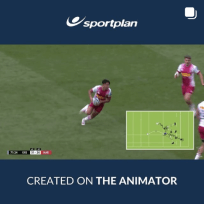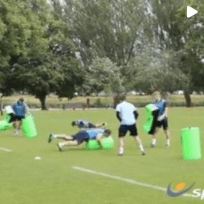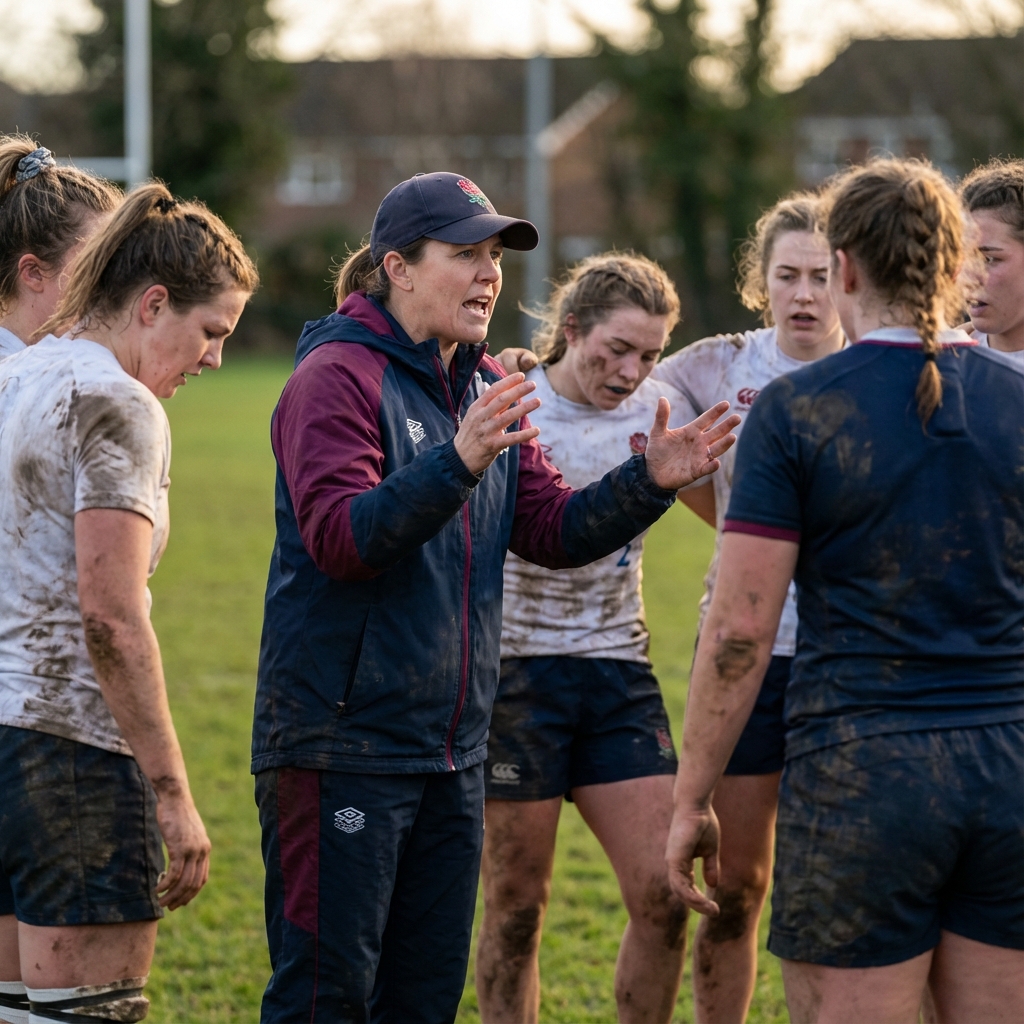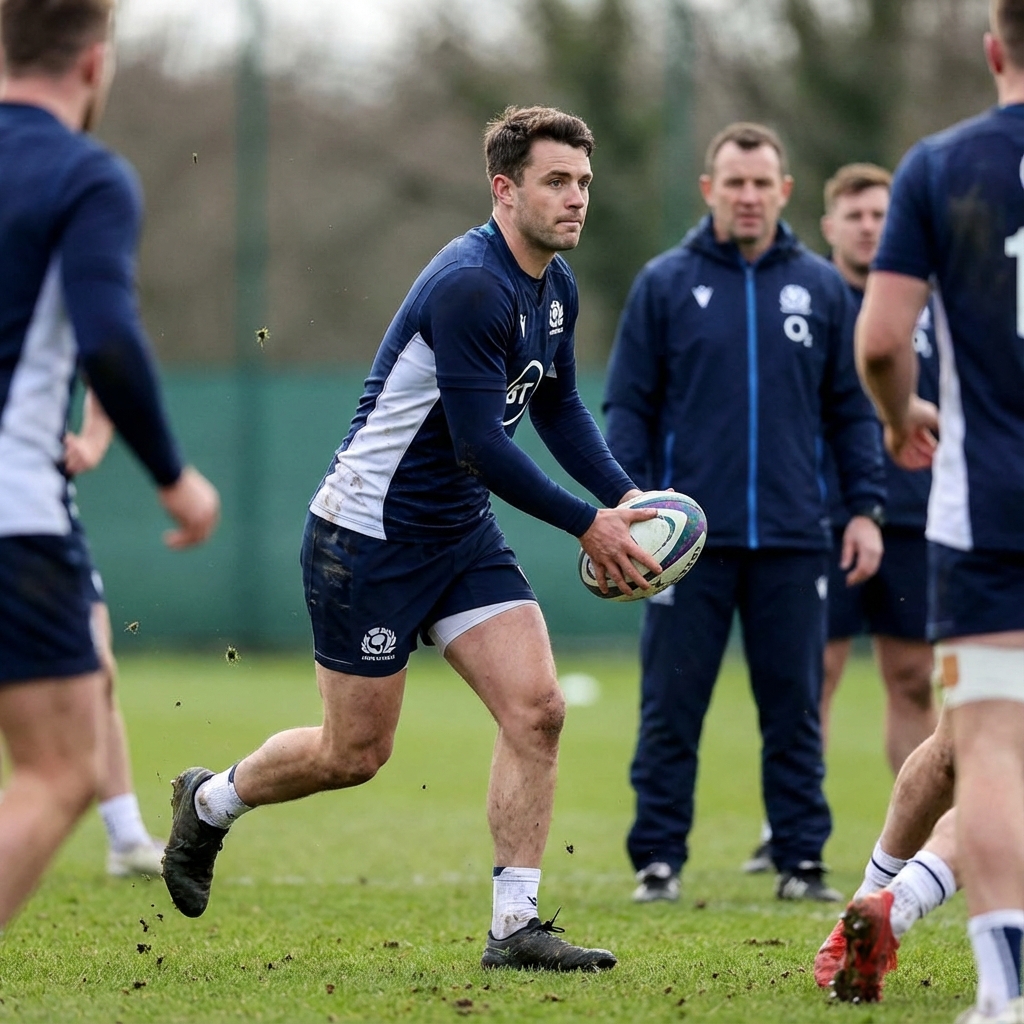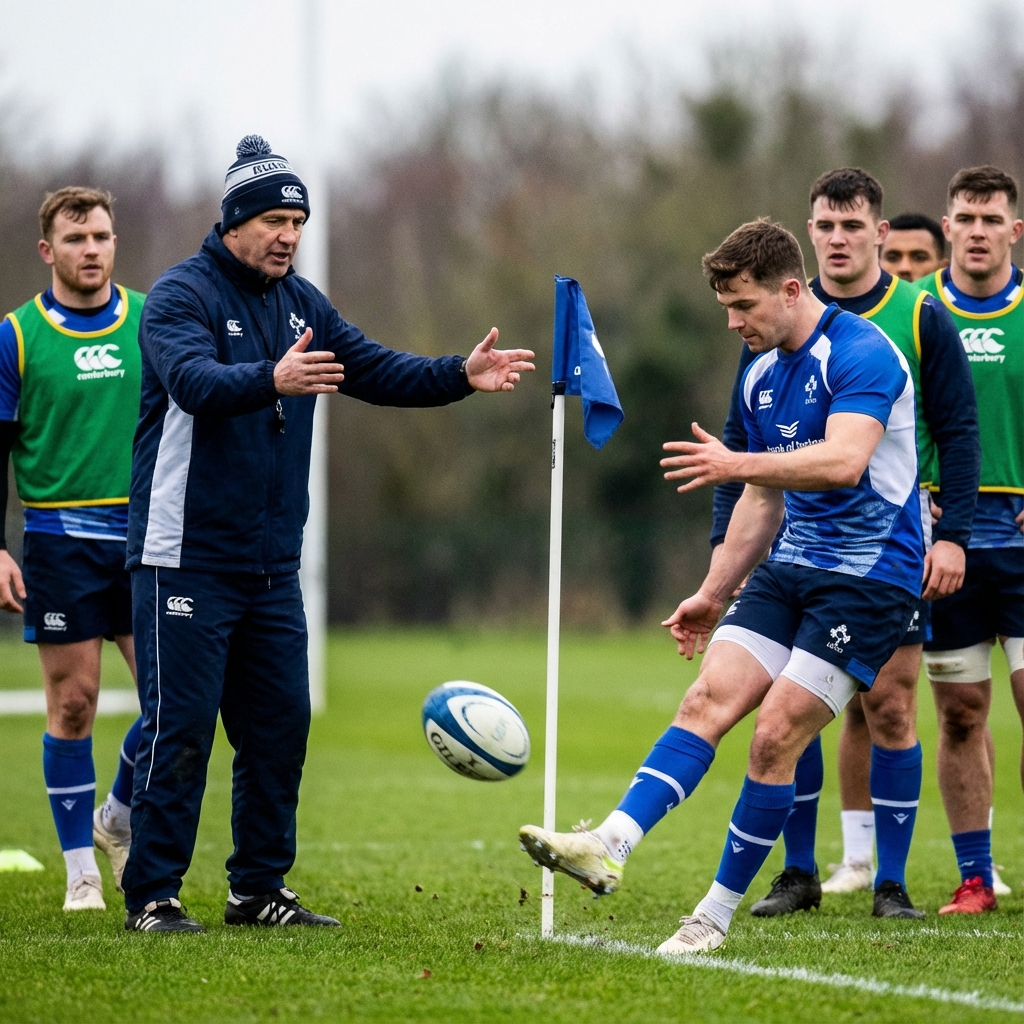Law 12 - the forward pass or throw forward
The law says that a forward pass is one "thrown forward" "in the direction of the
opponents' goal line"
Does that mean that, if the ball is passed and the receiver catches it NEARER to the
opponents goal line than from where the ball was passed that the pass was forward?
(Leaving to one side any other touches of the ball that might have taken place.)
Maybe an example is better. Player 1 passes the ball sideways - releasing it on the 22
metre line. Player 2 (with no other player having touched the ball), running from well
behind the 22 metre line, catches the ball when it has travelled sideways but the ball is
now 20 metres from the opponents goal line (2 metres further forward from the place that
the ball was passed).
Is that a forward pass or throw forward? And if not, why not?
Matthew
As you have stated, Law 12 says "thrown towards the opponents goal line"
So if you are running forward on the 22m line and pass backwards - even though the reciever catches the ball further forward (20m) than when it was thrown is the ball still travelling backwards?
Only the momentum of the passers has carried the ball forward.
What do you coaches think?.
Simon
PS - this is a wrong answer - see discussion below in other answers.
Dear Simon - thanks very much indeed for this. I hope I'm not taking too much of your time but this seems like a very important point for the IRB to be making. I must say I am very surprised by your answer. Does this mean that referees, coaches (and reporters) have to make a judgement call as to whether the player who has passed the ball has imparted forward momentum on the ball? And, one would think, we also have to judge how much tolerance is allowed for momentum. For a player who is stationary presumably there's no tolerance - the ball must not travel forward. But what about a player who is running forward and is stopped dead in his tracks by a tackle - is the receiver still allowed to take the ball in advance of where the tackle took place? And what does one do in the case where someone passes the ball backwards but the wind blows it in the opposite direction towards the opponents' line. Is that forward? Finally, following your answer, we could see a situation where a player passes the ball on the try line and the receiver catches it perhaps five yards over the goal line and, as long as the direction the passer sent the ball in was backwards, that would be given as a try. Seems like a controversial issue and one that the laws ought to address more fully, to give the rugby community clarity on what they are seeing. If we are saying that the only judgement a ref has to make is whether the player passed the ball sideways or backwards and the destination of the ball is not relevant, then that's a vital piece of information. Thanks very much for your help with this. With very best wishes Matthew Loukes
I must say I'm a little surprised by Simon's answer, but maybe I'm misinterpreting. Now, I lay no claims to being an expert, but to my knowledge the motion of the players has absolutely nothing to do with the definition of a forward pass. In fact, as stated in the rulebook, "âForwardâ means towards the opposing teamâs dead ball line." That would appear to me to be unequivocal%3A the ball leaves the player's hands and then moves in a direction that brings it closer to the opposition try line. So, as I understand it, at the moment the ball leaves the passer's hands a horizontal line (i.e. parallel to the try lines) should be drawn through the ball; it must not then touch either another player or the ground in front of that line. Indeed, it certainly used to be that technically not even sideways was allowed. By the way, the parenthetical remark of "Leaving to one side any other touches of the ball that might have taken place." is quite out of place since it is the relative position of the very first touch after the pass that counts. If the initial pass is not forward, it then becomes the responsibility of whoever touches the ball next and it is with respect to their position on touching that decides whether the successive motion is forward or not. Note also finally that if, e.g., the pass is properly backwards but hits the ground (i.e. behind the passer) and then bounces forwards, this is not deemed forward even if the final position of the ball is forward withe respect to where it was passed.
Wow - you have made me scratch my head now!
I think you are right - if the ball is passed backwards then even with forward momentum the ball will be further back from the point on the ground where it was passed by the time it is caught by the supporting player. If not then it would be a forward pass!
That's made me wake up this morning!
Simon
Thanks again, Simon. I agree it is quite difficult and I don't doubt for a moment that the optical illusions of players and officials running together makes things look different from different angles. Lots of tries in internationals are given in these circumstances (Halfpenny, Wales v Eng; Gear, Eng v NZ, Wilkinson, Wales v Eng) but one is left feeling unsure if that's an official making an error or appying the law correctly. We need a definition on this one. The key thing for me is that the law 12 needs to be clear about its meaning. In particular, to say whether or not the destination of the ball, relative to the opponent's goal line is relevant or not. It seems to me that a definition that relies on the forward momentum of the player is flawed in that if the player stops, or is stopped, on throwing the pass and the receiver takes the ball in front of the stopped passer then it's given as a forward pass, but if the runner does not stop then it isn't. That seems unsatifactory. I am sure you have already spent too much time on this issue so thanks so much for your assistance. Perhaps it's time for the IRB to make a statement. Thanks again Matthew
Hi Simon (and the other IRB community members). Do we have a view now on what is a forward pass? I'd like to address some rugby players on this issue and I'd be grateful for a definitive answer. Sorry to be such a nuisance on these busy weekends. All the best matthew
Guys, I think you are making this a bit more complex than it should be. Sure we see Refs making interesting decisions but rarely are they perfectly in line and they are dealing in real time. The ball must, as posted, travel backwards from the player's hands. That's about it. If a strong wind now blows it in front of the point of the pass (cos the player himself will also have travelled forward), the pass remains good. If the ball travels backwards hits the ground at an interesting angle and travels in front of the point of the pass, the pass remains good. To visualise, freeze frame the pass from a bird's eye view and consider the initial vector out of the player's hand. Forward or back? Play on or scrum down (/advantage)?
I believe that Simon's first answer (and Andy's answer above) is entirely correct. Law 12 says that the ball must not be thrown or passed towards the opposing team's goal-line. If the ball is thrown backwards (out of the hands) but, due to the forward momentum of the passing player, the ball is closer to the opposing team's goal-line when the next player catches it this is not a forward pass. So, Matthew, your example is not a forward pass. The reason for this is because the ball was thrown sideways and momentum caused it to drift forward. Your example about the forward pass on the goal-line would never happen in practice. Anyone moving at that speed to cause the ball to drift that far forward would surely just score themselves! A player running at 5m/s (which is pretty slow - 20s for 100m) would see the ball drift forward 5m from a perfectly flat pass if it took 1s to reach the next player. This would mean all players running at pace would have to throw the ball at least 5-10m behind them to avoid a forward pass. I would think such an interpretation of the law would ruin runnning rugby. On a related topic what exactly is a deliberate forward pass? I have never seen a penalty given for that in spite of sometimes seeing players handing the ball to a person standing to their side but slightly in front of them. If that is not a deliberate forward pass what is?
Thanks guys. And sorry to be such a pain in the you know where. But what about the issue of a guy passing the ball backwards from the hand who is then stopped in the tackle, perhaps on the goal line. The ball carries forward with momentum, say 3 yards and is caught. Do refs give the try ot not? The law says nothing at all about the direction of the hands or momentum. I am so sorry to go on about this but I'm worried about where we might be heading (see the winner in the League final (NZ v Aus) for a prime example of this kind of thing). I completely agree that the game is for the players and the officials to sort out and that loads of potential offences have to be let go for pragmatic reasons. But on this issue, I guess what I'd like is for the IRB to make the call. Maybe this forum is the wrong place for that. Perhaps i should take this up through a different channel. I really appreciate the input but what I am really after is a defintive IRB view that I can report on. Thanks to everyone who has been so generous with their time.
The answer is simple. Assuming no contact is made with the ball (either by another player or the ground) the pass is forward, if it is rec'd closer to the opposing team's dead ball line (not try line). As a referee, I'd love to have a "birdseye view" of the ball and it's flight, but I'm not superman (bloody close - I have to say!!!) All I can do is make a call based on pitch lines (try line, 22, 10 & halfway) and my own position. If the ball travels forward from a tackle - it's a knock on or forward pass. Simple. The ref's call (wrong or right) is the only call. Let's not go down the route of Football/Soccer where the ref is rarely respected.
[link removed] does this you tube link help!!!!??
This was on another forum recently and there was a link to a website that had film with lines across trying to show that a "momentum pass" was legal. It is not.The IRB said it was not valid and it appeared to be that they were trying to get the law interpreted differently. Rugby League apparently has adopted a concept of a "momentum pass" but I do not know the laws there well enough. Law 12 is unequivocable the ball must not travel towards the opponents tryline.
Gosh, we're still going on with this one?!?
It really is simple: draw a static line through the ball and parallel to a try line at the instant it is released; the first successive contact of the ball with the ground or another player must then not be beyond this line. That's it.
Now, as Alexander put it, if you're asking referees to be superhuman, then that's another question, The answer is, of course, that they're not. Fortunately though, rugby has always had a very tolerant attitude towards their very human flaws and I for one am more than happy with it that way.
P.S. I do believe that any referee does, indeed, know the correct answer to this question.
@bryan I don't see where Law 12 says unequivocably that the ball must not travel towards the opponents goal-line. This is actually what Law 12 gives as the definition of a forward pass%3A "A throw forward occurs when a player throws or passes the ball forward. âForwardâ means towards the opposing teamâs dead ball line." It mentions nothing about the path of the ball or where it is caught in relation to the passer. The only unequivocable thing is that the ball must not be thrown/passed towards the dead ball line. What part of the definition is violated if a person passes the ball backwards but due to momentum another player catches the ball closer to the dead ball line than where the pass was thrown? I can't see any. For more than 20 years I have watched rugby assuming that momentum was OK, I have never heard or seen anything that would make me think that it was any other way. In fact, it used to be one of the points of difference between rugby and rugby league - in league the ball had to be caught behind the line across the field from where the ball was thrown while in rugby it could drift forward. League recently (not exactly sure but it may have been as recent as 5 years ago) adopted the same rule with regards to forward passes. Perhaps Simon can find out which interpretation is correct? I'd be happy to know for sure which is correct.
@bryan You said that the IRB said that momentum was not valid. Do you have a link to this?
Thanks to everyone for the patience and information - it does seem as though there's a difference of view. Which is why I suggested (and have tried to obtain) an IRB statement on this. I'm going to write a letter directly to them to see if we can get an answer. Not to prove a point or "win an argument" but to clarify something that ought to be (and many of you firmly believe is) a simple matter. As I have also said before, respect for the officials is one of the greatest things about Rugby and we ought to be in a situation where the law is clear to them, the players and even the spectators. Thanks again.
A top player can be travelling up to 25mph forward, and a sideways(& legal) pass WILL invariably be caught nearer to the opposition try line as a result.... you can't defeat the laws of physics in afraid! Wayne Barnes was wrongly castigated by the NZ press over this very issue. Test it yourself , throw a malteaser backwards up in the air out of a train window [when the train is doing 150mph - £1k says it'l land further forward than where you released it from ......any takers? it's a fair point though, how do we stop the media from replaying these things in slow motion and criticising wrongly?
CRAIG, I disagree with you ............. Law 12 DEFINITION%3A THROW FORWARD A throw forward occurs when a player throws or passes the ball forward. âForwardâ means towards the opposing teamâs dead ball line. Law 12 prohibits a ball being thrown forward, it does not prohibit a ball being passed sideways or a ball from travelling toward the opponents line that has just been released sideways or backwards. unequivocal -- !
The ambiguity is in the wording of Law 12.
"A throw forward occurs when a player throws or passes the ball forward. 'Forward' means towards the opposing team's dead ball line".
The key word is *towards*. If I throw a ball 'away' from you, but it *ends up* (due to my momentum) going *towards* you, did I (effectively) throw the ball *towards* you?
Answer A. No. I did not throw the ball *towards* you. I threw it *away* from you, within my frame of reference. The reason it *went towards* you was momentum, which had a greater force than the amount I threw the ball away from you.
Answer B. Yes. I must have thrown the ball 'towards' you, as how else could it have reached you. The fact that it was 'away' from me within your frame of reference is irelevant to the fact that the ball ended up travelling *towards* me.
People of good will can disagree on how to parse this sentence.
I have my own opinion on which would be the *best* interpretation, but that's not relevant. I just want to make clear that either interpretation is a reasonable reading of Law 12.
So (until the IRB decide to clarify the wording),the question is how does the *IRB* and referees interpret this wording?
Hi, IMHO the point of receipt is irrelevant...... The pass is the action being questioned as I see it the passer finishes this task the moment it leaves his hands and therefore it is at this the point of release only that a forward pass is determined. if it leaves the hands back of the horizontal then it is not a forward pass any subsequent fight is not controlled by the player. As a player it is disappointing to hear the word interpretation so much from referees ... the purpose of the law is to clarify what a player can do. If you watch videos and freeze the point of release and receipt you will see that a large percentage are received ahead of where they are passed ... this is correct as long as the pass is propelled back from the passing players hands.
Thanks again to one and all. I have written to the IRB (and the RFU) but no formal answers, which is disappointing, but here, at last, is something that we can use as a workable and unequivocable statement from the IRB. This is an IRB Document (see page 4) [link removed] here's what is says, word for word%3A "A player may pass (throw the ball) to a team mate who is in a better position to continue the attack, but the pass must not travel towards the opposing teamâs goal line. It must travel either directly across the field, or back in the direction of the passerâs own goal line." No momentum. No relative positions. No hand movements. Nothing except the "PASS MUST NOT TRAVEL TOWARDS THE OPPOSING TEAM'S GOAL LINE" That seems definitive but it's not what's actually written in the Laws but in the absence of the IRB making a revision or a statement it's pretty clear. Funnily enough, IRB referee Mark Lawrence, doesn't agree - he's of the view that momentum means forward passes are permitted. Hmm. One thing in a published IRB document, another in the LAWS and a third from a leading ref. How about we all get together and urge the IRB to make it all clear? People say it's not worth worrying about and that, like with many laws, one has to use common sense. That's fair enough but this is fundamental to the game and easy to sort out. Thanks again to all for the patience and interest.
Not surprisingly, I agree with Aaron and the reported views of Mark Lawrence. A couple of references may help. Refer page 9 Definitions - A pass occurs WHEN a player throws or hands the ball to another player; and, Law 12 DEFINITION%3A A throw forward occurs WHEN a player throws or passes the ball forward. Of course the consequences of wind and momentum take effect after the ball carrier has released the ball. But the law does not focus on these. It is concerned with the throwing action of the ball carrier at the time of the pass. It is this action that Law directs our attention when making a decision on whether or not to rule a forward pass. In practice only those passes that appear to go forward would cause the referee to reflect on whether the pass was indeed made with a forward movement of the arms and hands. Paul Phillips (NZ)
@Kevin Brown, if you read my posts (again) you will find that you agree with me. @Matthew, what was the document you got the last statement from? I agree with you that (to me) it contradicts what's in the laws. I guess if the laws and a leading ref both say that the ball is allowed to drift forward with momentum then I am happy to continue to believe that. It would be nice if Simon would clarify this for us. Surely he is in the ideal position to do so and the fact that he was unsure to start with and has yet to come up with an decision is unsettling.
Hi Craig The document is from the IRB website. One can't post links on this forum but if you do a google search on "irb beginners" it will bring it up as the first 2 items, both on the IRB site itself. That will take you to a PDF file and look at page 4, where the quoted text seems to me to be completely unequivocal. Here's the paragraph in full. "PASSING - A player may pass (throw the ball) to a team mate who is in a better position to continue the attack, but the pass must not travel towards the opposing teamâs goal line. It must travel either directly across the field, or back in the direction of the passerâs own goal line." Someone at the IRB ought to be able to give a simple answer to this, so we can tell players and the public what's going on and what's permitted. As I have said before, a definition of a forward pass that relies on complex ideas of vectors and momentum seems to me to be unsatisfactory and contradictory. Thanks again to all of you.
Folks
This has been a great debate and I am glad to see the website being used for this sort of discussion.
I have been asked by Craig to give a definitive answer so here it is:
DEFINITION: THROW FORWARD A throw forward occurs when a player throws or passes the ball forward. âForwardâ means towards the opposing teamâs dead ball line.
EXCEPTION Bounce forward. If the ball is not thrown forward but it hits a player or the ground and bounces forward, this is not a throw forward.
This is the Law and we have pretty much exhausted the ways of interpreting this. Needless to say, the decision maker that counts is the ref and when I asked a top English ref for his view, he was quite clear:
"During play I will judge whether the pass has gone forward in relation to the player passing the ball and so will my touch judges. By forward, I mean that the player passes the ball so it travels towards the opposing dead ball line. Points of reference on the ground are not relevant as the player will be travelling forward and therefore so must the ball in relation to a fixed point but it must be passed backwards."
I hope that clears things up at least a little.
Thanks to Matthew for starting the debate and to all of you for contributing. It might be interesting to draw people's attention to the debate in this months newsletter!
Simon
What an extraordinary statement by "a top English ref". Nowhere in the Law does it require the player with the ball to be stationary or pass backwards when making a lawful pass. The only "point of reference" identified in the definition is that moment "when" the ball carrier releases the ball. If, at the time of its release, the ball is travelling forward toward the opponents dead ball line, then it is a forward pass. The Law makes no reference to the relative positions of the players passing or receiving the ball (either or both could be stationary). The Law is not concerned with the length of the pass or whether its ultimate direction is affected by wind or rain etc, but it is simly concerned with its direction when it is released. Put more directly, if a player passes the ball backwards and it is blown forward 5 paces from from the point of release, it is not a forward pass. Neither is it a forward pass if the momentum or speed of on-side players, or the wind results in the ball being blown forward so that it is caught ahead of the player making a sideways pass. There is NO requirement that the receiver be behind the passer when he receives a pass, but of course he must be an on-side player to do so. Hopefully what I have said will give our top English Referee cause for further thought.
So, if that is the case, why is there an IRB guide to rugby, on its own website, that says
"A player may pass (throw the ball) to a team mate who is in a better position to continue the attack, but the pass must not travel towards the opposing teamâs goal line. It must travel either directly across the field, or back in the direction of the passerâs own goal line."
No momentum. No relative positions. No vector diagrams. No hand position. Nothing except the "PASS MUST NOT TRAVEL TOWARDS THE OPPOSING TEAM'S GOAL LINE".
I hate to seem picky and repetitive but no-one seems able to answer this question and it's very frustrating.I don't have an agenda here, I just want to know what the IRB position is.
I'll make this simple ........... A ball released/passed/thrown 'exactly' sideways/lateral WILL travel forward of it's release point if the player releasing it is travelling forward at any significant speed................... You can't defy physics !
Long passes exagerate the illusion that it was released in a direction toward the opponents line.
release a tennis ball backwards up in the air from a car travelling 30kmph and see if it lands in front of where you released it backwards
I read this both ways for a forward pass and a ball thrown forward. A forward pass is a pass that has gone slightly infront of the passing player! Scrum awarded. A ball thrown forward to a team mate is intenional. Penalty. Two reasons. 1, The pass forward was intending to gain ground. 2, the team mate receiving the ball is in an off side position.









